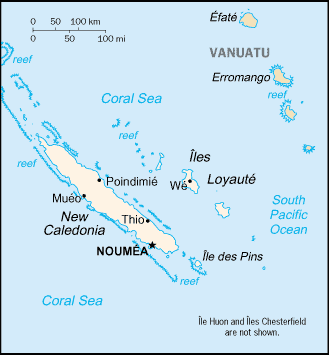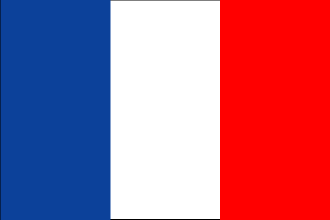
|
New Caledonia
Background:
Settled by both Britain and France during the first half of the
19th century, the island was made a French possession in 1853. It served as a
penal colony for four decades after 1864. Agitation for independence during the
1980s and early 1990s seems to have dissipated.
Location:
Oceania, islands in the South Pacific Ocean, east of Australia.
Geographic coordinates: 21 30 S, 165 30 E.
Area: Total: 19,060 sq km, land: 18,575 sq km, water: 485 sq km.
Area - comparative: Slightly smaller than New Jersey.
Coastline: 2,254 km.
Climate and Terrain:
Tropical; modified by southeast trade winds; hot, humid.
Coastal plains with interior mountains.
Elevation extremes: Lowest point: Pacific Ocean 0 m, highest point: Mont
Panie 1,628 m.
Natural resources: Nickel, chrome, iron, cobalt, manganese, silver, gold, lead,
copper.
Land use: Arable land: 0%, permanent crops: 0%, permanent pastures: 12%,
forests and woodland: 39%, other: 49%.
Irrigated land: 160 sq km.
Natural hazards: Cyclones, most frequent from November to March.
People:
Population: 204,863.
Ethnic groups: Melanesian 42.5%, European 37.1%, Wallisian 8.4%, Polynesian
3.8%, Indonesian 3.6%, Vietnamese 1.6%, other 3%.
Religions: Roman Catholic 60%, Protestant 30%, other 10%.
Languages: French (official), 33 Melanesian-Polynesian dialects.
Government:
Overseas territory of France since 1956.
Capital: Noumea.
Economy overview:
New Caledonia has more than 20% of the world's known nickel
resources. In recent years, the economy has suffered because of depressed
international demand for nickel, the principal source of export earnings. Only
a negligible amount of the land is suitable for cultivation, and food accounts
for about 20% of imports. In addition to nickel, the substantial financial
support from France and tourism are keys to the health of the economy. The
situation in 1998 was clouded by the spillover of financial problems in East
Asia and by lower prices for nickel. Nickel prices jumped in 1999-2000, and
large additions were made to capacity.
Labor force: 79,395 (including 15, 018 unemployed, 1996).
Labor force - by occupation: agriculture 7%, industry 23%, services 70%.
Unemployment rate: 19%.
Industries: nickel mining and smelting.
Statistics:
Telephones - main lines in use: 47,000.
Telephones - mobile cellular: 13,040.
Radio broadcast stations: AM 1, FM 5.
Radios: 107,000 (1997)
Television broadcast stations: 6 (plus 25 low-power repeaters).
Televisions: 52,000.
Internet country code: .nc
Internet Service Providers (ISPs): 1.
Internet users: 5,000.
Railways: 0 km
Highways: total: 4,825 km, paved: 2,287 km, unpaved: 2,538 km.
Airports: 29.)
Heliports: 6.
Return to Visiting Locations
|

